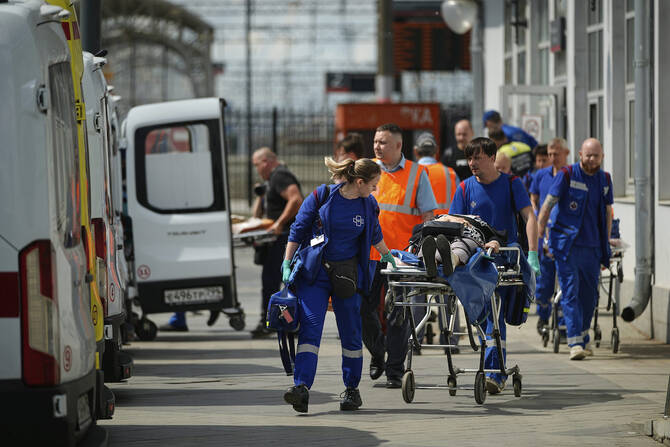Ukraine Strikes Russian Bombers Ahead of Istanbul Peace Talks
Long-range drone strike shakes pre-summit diplomacy
On the eve of highly anticipated peace negotiations in Istanbul, the Russia-Ukraine war surged with unprecedented intensity. In a bold move, Ukraine launched a strike on Russian nuclear-capable bombers stationed deep within Siberia — more than 4,300 kilometers from the front line. This marks one of the most audacious attacks since the war began, just as diplomatic discussions were poised to resume.
Ukraine confirms delegation amid uncertainty
Amid this brewing chaos, Ukrainian President Volodymyr Zelensky confirmed that Defense Minister Rustem Umerov would represent Ukraine at the second round of direct peace talks with Russia. This announcement came after significant uncertainty regarding Ukraine’s participation. While the first round of talks achieved a major prisoner exchange, there was little indication of any meaningful consensus on a ceasefire or resolution.
Bryansk bridge blast escalates tensions
Despite the diplomatic backdrop, hostilities intensified across multiple fronts. At least seven people were killed and 69 injured when a highway bridge in Russia’s Bryansk region — near the Ukraine border — exploded beneath a passenger train carrying 388 individuals. The bridge’s collapse has yet to be claimed by any group, raising further tension and speculation around potential sabotage or coordinated attack.
Hidden drone assault reveals covert tactics
The Ukrainian strike on the Russian bombers employed a remarkably covert tactic. According to a Ukrainian intelligence official, explosive-laden drones were hidden inside wooden sheds and discreetly transported via trucks to the perimeter of air bases. Once inside, they struck targets with devastating accuracy, reportedly damaging or destroying 41 Russian aircraft.
Russia confirms multi-region airfield attacks
The Russian Defense Ministry later confirmed on Telegram that Ukrainian drones targeted airfields across five different regions. While most attacks were repelled, the regions of Murmansk and Irkutsk — both far from the Ukrainian border — experienced fires as first-person-view (FPV) drones reached sensitive areas. Though fires were quickly extinguished and no casualties reported, the psychological and strategic impact was substantial.
Largest Russian drone barrage recorded
Russia launched an overwhelming 472 drones overnight, marking the largest single-night assault of the war. Ukraine’s air force reported that seven missiles were also fired, showcasing the sustained pressure Russia is exerting on multiple Ukrainian fronts. Meanwhile, Russian forces continued their push into Ukraine’s Sumy region, with open-source maps confirming that Moscow gained about 450 square kilometers in May — its fastest monthly advance in half a year.
Trump pushes ceasefire, threatens aid withdrawal
Amid escalating violence, former US President Donald Trump called on both sides to agree to peace, threatening to withdraw US support if they do not. Trump’s stance potentially places the burden of future aid on European allies who lack Washington’s financial and military resources. Trump’s envoy Keith Kellogg indicated both parties will present peace frameworks during the Istanbul summit, though stark disagreements remain.
War timeline and rising casualty estimates
In February 2022, President Vladimir Putin launched a full-scale invasion of Ukraine following eight years of conflict between Russian-backed separatists and Ukrainian forces in eastern Ukraine. Since then, the US estimates over 1.2 million casualties, including both killed and wounded, underscoring the immense human toll of the war.
Peace terms remain sharply divided
Trump, despite publicly criticizing both Putin and Zelensky, maintains that peace is possible. He warned that further delays could prompt severe sanctions against Russia. Last year, Putin issued demands for a ceasefire — including Ukraine’s withdrawal from NATO ambitions and surrendering occupied territories — but Kyiv has firmly resisted these terms.
Ukraine to propose roadmap for peace
At the upcoming talks, Ukrainian delegates will present a roadmap for lasting peace, according to a document obtained by Reuters. The proposal demands no international recognition of Russian-held territories, reparations for damages, and no limits on Ukraine’s military capabilities post-conflict. The front lines as they currently stand would serve as the starting point for territorial negotiations.
Russian control spans one-fifth of Ukraine
As of now, Russia controls just under 20% of Ukraine, roughly 113,100 square kilometers, comparable to the size of Ohio. With the conflict entering a new phase of long-range strikes, drone warfare, and increased international pressure, the world watches closely as the Istanbul peace talks unfold.







